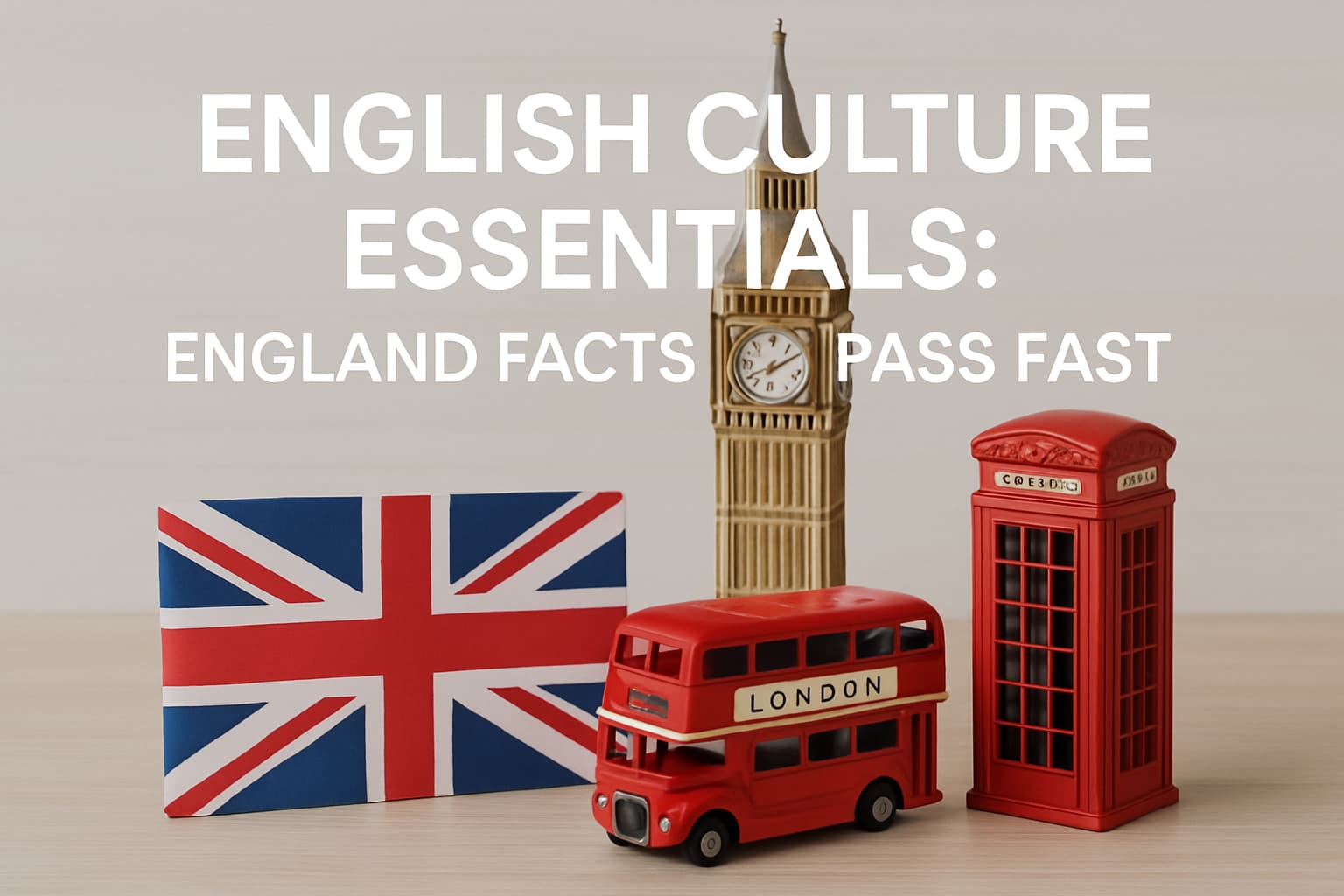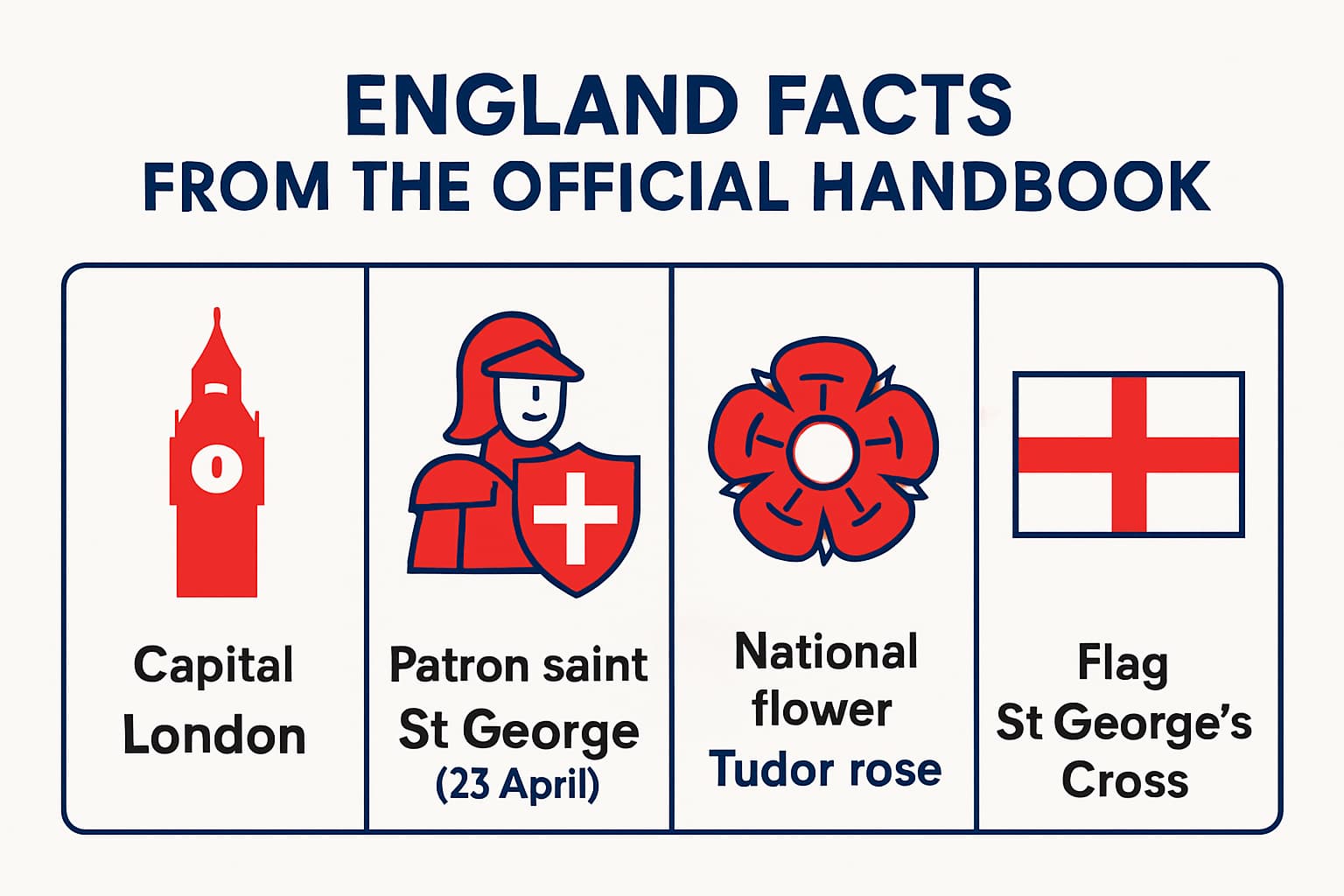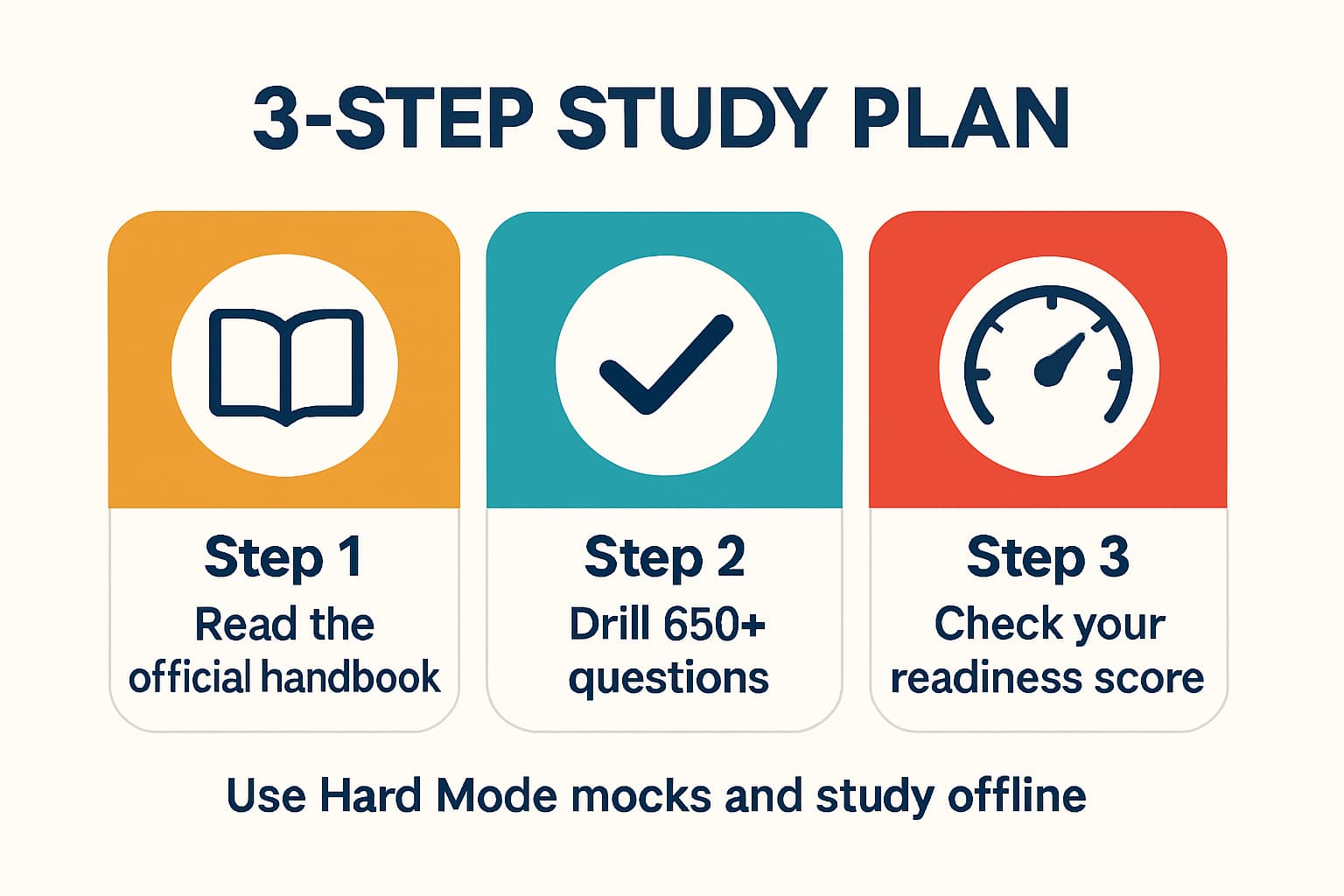English culture essentials: England facts for the test

Studying English culture for the Life in the UK Test? Here is the fast, handbook-accurate way to lock in England’s capital, symbols, culture, foods and landmarks. Everything below is distilled from the official Guide for New Residents (3rd edition) so you can learn only what is tested, nothing extra.
In minutes you will: see England at a glance, memorise high‑yield symbols, review culture and foods named in the book, tick off major sites, practise with quick Q&As, avoid mix‑ups, and use our app to study efficiently.
How to use this guide (official-handbook only)
This article focuses on England facts exactly as taught in the 3rd edition Life in the UK Handbook. Every test question is based on that book, so studying outside it can waste time. See the official booking and format details on the UK government site and trusted legal guides:
- GOV.UK: Life in the UK Test — book online, 24 questions in 45 minutes, £50 fee
- Paragon Law overview — pass mark is 75% (18/24)
- DavidsonMorris guide — confirms the 3rd edition handbook coverage
What you will (and won’t) find here
- Included: England facts on capital city, symbols, culture, foods, and landmarks explicitly named in the handbook.
- Excluded: speculative trivia, regional debates, or “unofficial” national dishes not in the book.
- Need the wider syllabus? See our Life in the UK Test Topics: The Definitive Syllabus.
Study smarter, not longer
Use this focused flow to learn England’s testable facts fast.
- Skim the England snapshot (capital, place in UK).
- Memorise the three symbols (patron saint/date, national flower, flag).
- Review culture, foods, and key sites that the book names.
- Drill 10 quick Q&As for recall speed.
- Rehearse mix-ups (UK vs Great Britain; capitals).
- Finish with the 60‑second checklist.
Short on time? The Life in the UK Test App compresses the handbook into mobile sessions, with a readiness score so you know when you’re exam-ready. It includes 650+ questions, detailed explanations, Hard Mode mocks, and offline study.

England at a glance (per the handbook)
Anchor these core facts before learning the details.
England capital city: London
London is England’s capital. For the test, link London to national institutions: the UK Parliament at Westminster and major historic buildings. See our quick visual guide to Trafalgar Square and Parliament to reinforce London’s role.
England’s place in the UK
England is one of the four countries of the United Kingdom, alongside Scotland, Wales and Northern Ireland. England, Scotland and Wales together form Great Britain; add Northern Ireland and you have the United Kingdom of Great Britain and Northern Ireland.
Symbols to memorise (high-yield facts)
These symbols are classic test items for England. Fix the associations precisely.
Patron saint of England: St George (23 April)
Know the name and date together: St George; St George’s Day is 23 April.
England national flower: the Tudor rose
The Tudor rose is the national flower of England. Its name recalls the Tudor period. For broader Tudor-to-Stuart context, review our English history guide: Tudors, Stuarts, Religion.
Flag of England: St George’s Cross
England’s flag is the red cross of St George on a white field. Do not confuse it with the UK’s Union Flag.
English culture in the handbook: arts, sport, life
The handbook introduces english culture through literature and theatre, major sports with English roots, and shared observances.
Literature and theatre (e.g., Shakespeare)
- William Shakespeare — England’s most famous playwright; his works and the Globe/Royal Shakespeare tradition are widely referenced.
- Jane Austen — English novelist whose works portray society and manners.
- Charles Dickens — English novelist linked with Victorian London life.
Sport with English roots: football, rugby, cricket
Football, rugby and cricket developed in the UK and are central to cultural life in England. Know these as sports with English roots and strong national followings.
National days and customs
Remember St George’s Day on 23 April as England’s key observance named in the handbook.
Traditional English food named in the handbook
Only list items mentioned in the handbook. Avoid claiming an “official” national dish.
Roast beef and Yorkshire pudding
A traditional English meal highlighted in the book.
Fish and chips
A classic English dish also cited by the handbook.
England landmarks and heritage sites in the handbook
These appear frequently and are easy marks if you recognise the names and locations.
London highlights: Parliament, historic buildings
Associate London with national government at Westminster, and with historic buildings you may meet in questions. Revisit Trafalgar Square and Parliament for quick recall drills.
Stonehenge and Hadrian’s Wall
Stonehenge in Wiltshire is a prehistoric stone circle; Hadrian’s Wall spans northern England, once marking the Roman Empire’s frontier. Both are iconic sites named in the handbook.
The Lake District and national parks
The Lake District in Cumbria is England’s best-known national park and a popular subject in questions about countryside and outdoor culture.
Ten quick practice Q&As (England-specific)
Sample questions with brief explanations
- What is the capital of England? London. It hosts the UK Parliament at Westminster.
- Who is the patron saint of England? St George. His day is 23 April.
- What is England’s national flower? The Tudor rose. Memorise it with the flag and saint.
- Which flag represents England? St George’s Cross: a red cross on white.
- Name an English literary figure from the handbook. Shakespeare (also Jane Austen or Charles Dickens).
- Which sports have English roots? Football, rugby and cricket.
- Which traditional English meal is cited? Roast beef with Yorkshire pudding.
- Which classic English dish is cited? Fish and chips.
- Name a prehistoric or Roman site in England from the book. Stonehenge or Hadrian’s Wall.
- Which national park is highlighted? The Lake District in Cumbria.
Common mix-ups to avoid on exam day
These short definitions are designed for fast recall and featured-snippet style memory.
England vs Great Britain vs United Kingdom
- England: One of four UK countries.
- Great Britain: England + Scotland + Wales.
- United Kingdom: Great Britain + Northern Ireland.
London vs the other UK capitals
- England capital city: London.
- Scotland: Edinburgh (see our Scotland capital city guide).
- Wales: Cardiff.
- Northern Ireland: Belfast.
For broader pitfalls, read 7 Common Life in the UK Test Mistakes to Avoid.

Study faster with the Life in the UK Test App
You must book your test online and bring exact-matching ID; there are 24 questions in 45 minutes, and you need 75% to pass. See GOV.UK for booking, centres and ID rules, and the pass mark confirmation via Paragon Law. Questions are random and may require multiple answers, so read carefully, as noted by DavidsonMorris.
Brit-Bear assistant and 650+ questions
Target weak spots fast. Brit‑Bear suggests bite‑size sessions and explains answers so the facts stick. The 650+ question bank mirrors handbook coverage, and Hard Mode mocks simulate real exam pressure.
Track your readiness and study offline
See a live readiness score so you don’t over- or under‑prepare. Download question sets for offline practice so travel or breaks become effective study time.
Download links
- Download on App Store: https://apps.apple.com/app/id6743702124
- Get it on Google Play: https://play.google.com/store/apps/details?id=net.briceventures.life_in_the_uk_test
Note: Some candidates take the test many times, which is stressful and costly. Preparing well with official content reduces that risk (see news coverage on repeated attempts in the Independent).
Final 60-second England checklist
- Capital: London.
- Patron saint: St George — date: 23 April.
- National flower: Tudor rose.
- Flag: St George’s Cross (red cross on white).
- Culture: Shakespeare, Jane Austen, Charles Dickens; sports with English roots: football, rugby, cricket.
- Food (named in book): Roast beef with Yorkshire pudding; fish and chips.
- Landmarks: Parliament at Westminster; Stonehenge; Hadrian’s Wall; the Lake District.
Ready to lock this in? Take a Hard Mode mock and check your readiness:
- App Store: Install now
- Google Play: Install now
FAQ
What counts as english culture for this test?
The handbook highlights literature (e.g., Shakespeare, Austen, Dickens), sports with English roots (football, rugby, cricket), national symbols, foods, and landmarks.
What is England’s capital city?
London. It is the seat of the UK Parliament at Westminster and features in many test questions.
Who is the patron saint of England and when is his day?
St George; St George’s Day is 23 April.
What is England’s national flower?
The Tudor rose.
How many questions are on the Life in the UK Test?
24 questions in 45 minutes; you need 75% to pass. See GOV.UK.